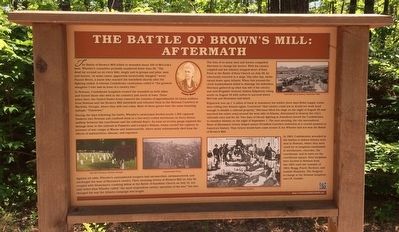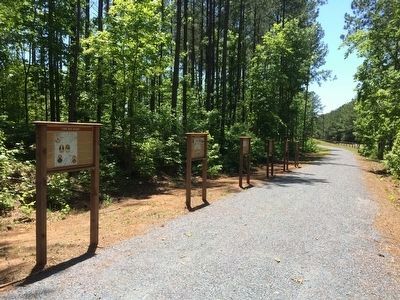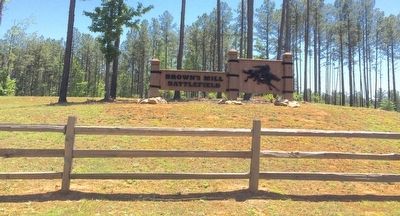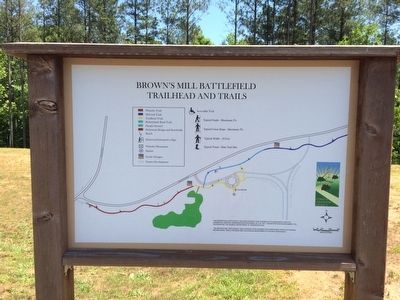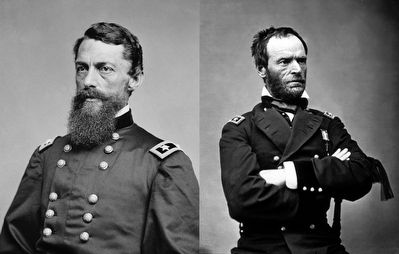Near Newnan in Coweta County, Georgia — The American South (South Atlantic)
The Battle of Brown's Mill: Aftermath
Brown's Mill Battlefield
The Battle of Brown's Mill killed or wounded about 100 of McCook's men. Wheeler's casualties probably numbered fewer than 50. "The dead lay around us on every side, singly and in groups and piles; men and horses, - in some cases, apparently inextricably mingled," wrote Fannie Beers, a nurse who reached the battlefield shortly after the fighting ended. A veteran Confederate cavalryman called it "the greatest slaughter I ever saw in front of a cavalry line."
In Newnan, Confederate hospitals treated the wounded on both sides, and buried those who died in the cemetery just north of town. Three years later, the United States Army removed the remains of approximately 34 Union soldiers from Newnan and the Brown's Mill battlefield and reburied them in the National Cemetery at Marietta, Georgia, where they still rest today. Most of these graves bear the same haunting epitaph: "Unknown.”
During the days following the battle, Wheeler's cavalrymen herded nearly 1,300 captured Yankees into Newnan and confined them in a two-story cotton warehouse on Perry Street, midway between the courthouse and the railroad depot. As soon as section gangs repaired the damage done to the railroad at Palmetto and Lovejoy's Station, trains carried the captives to prisoner of war camps at Macon and Andersonville, where many subsequently died from the effects of malnutrition, disease, and exposure.
Against all odds, Wheeler's outnumbered troopers had out-marched, outmaneuvered, and out-fought the best of Sherman's cavalry. Their stunning victory at Brown's Mill on July 30, coupled with Stoneman's crushing defeat at the Battle of Sunshine Church on July 31, not only foiled what Wheeler called "the most stupendous cavalry operation of the war," but also changed the way the Atlanta campaign was fought.
The loss of so many men and horses compelled Sherman to change his tactics. With his cavalry crippled and his infantry stopped short of East Point at the Battle of Ezra Church on July 28, he reluctantly resorted to a siege. Day after day, shells rained down upon Atlanta. When this around-the-clock bombardment failed to dislodge the defenders, Sherman gathered up what was left of his cavalry and sent Brigadier General Judson Kilpatrick riding south on August 18 with orders to succeed where McCook and Stoneman had failed.
Kilpatrick tore up 1½ miles of track at Jonesboro but within three days Rebel supply trains were rolling into Atlanta again. Convinced "that cavalry could not or would not work hard enough to disable a railroad properly," Sherman lifted his siege on the night of August 25 and marched his entire army around the west side of Atlanta, determined to destroy the city's
railroads once and for all. Two days of bloody fighting at Jonesboro forced the Confederates to abandon Atlanta on the night of September 1. The next morning, the city surrendered. News of Sherman's victory helped assure President Lincoln's reelection at a crucial moment in America's history. That victory would have come sooner if Joe Wheeler had not won the Battle of Brown's Mill.
In 1863, Confederates wounded in the battles to defend Atlanta were sent to Newnan, where they were cared for in hospitals established in warehouses, churches, the courthouse, and in tents on the courthouse square. Four hospitals were located in Newnan from late 1863 until late summer of 1864: Bragg, Foard, Buckner, and Gamble Hospitals. The Surgeon-in-charge at the Newnan hospitals was I. B. Gamble.
Erected 2013 by Coweta County, Georgia Departments of Transportation & Natural Resources.
Topics and series. This historical marker is listed in this topic list: War, US Civil. In addition, it is included in the Former U.S. Presidents: #16 Abraham Lincoln series list. A significant historical date for this entry is July 30, 1863.
Location. 33° 20.09′ N, 84° 50.357′ W. Marker is near Newnan, Georgia, in Coweta County. Marker can be reached from Millard Farmer Road, 0.4 miles east of Old Corinth Road, on the right when traveling
east. Touch for map. Marker is at or near this postal address: 155 Millard Farmer Road, Newnan GA 30263, United States of America. Touch for directions.
Other nearby markers. At least 8 other markers are within 4 miles of this marker, measured as the crow flies. The Battle of Brown's Mill: Ride for the River (here, next to this marker); The Battle of Brown's Mill: Detour to Battle (here, next to this marker); Wheeler's Pursuit (here, next to this marker); McCook's Raid (a few steps from this marker); "The Big Raid" (a few steps from this marker); Gen. Jos. Wheeler, C.S.A. (approx. 0.3 miles away); In Memoriam (approx. 0.3 miles away); William McIntosh (approx. 3.6 miles away). Touch for a list and map of all markers in Newnan.
Related markers. Click here for a list of markers that are related to this marker. To better understand the relationship, study each marker in the order shown.
Credits. This page was last revised on June 3, 2020. It was originally submitted on May 16, 2016, by Mark Hilton of Montgomery, Alabama. This page has been viewed 654 times since then and 34 times this year. Photos: 1, 2, 3, 4, 5. submitted on May 16, 2016, by Mark Hilton of Montgomery, Alabama.
